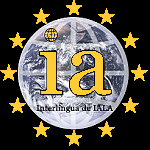Related Research Articles

Interlingua is an Italic international auxiliary language (IAL), developed between 1937 and 1951 by the International Auxiliary Language Association (IALA). It ranks among the top most widely used IALs, and is the most widely used naturalistic IAL – in other words, those IALs whose vocabulary, grammar and other characteristics are derived from natural languages, rather than being centrally planned. Interlingua was developed to combine a simple, mostly regular grammar with a vocabulary common to the widest possible range of western European languages, making it unusually easy to learn, at least for those whose native languages were sources of Interlingua's vocabulary and grammar. Conversely, it is used as a rapid introduction to many natural languages.
In neuropsychology, linguistics, and the philosophy of language, a natural language or ordinary language is any language that has evolved naturally in humans through use and repetition without conscious planning or premeditation. Natural languages can take different forms, such as speech or signing. They are distinguished from constructed and formal languages such as those used to program computers or to study logic.

Interlingue, known until 1949 as Occidental, is an international auxiliary language created by Edgar de Wahl, a Baltic German naval officer and teacher from Tallinn, Estonia, and published in 1922. The vocabulary is based on already existing words from various languages and a system of derivation using recognized prefixes and suffixes.
An international auxiliary language is a language meant for communication between people from different nations who do not share a common first language. An auxiliary language is primarily a foreign language. It usually takes words from widely spoken languages.
Alexander Gottfried Friedrich Gode-von Aesch, or simply Alexander Gode, was a German-American linguist, translator and the driving force behind the creation of the auxiliary language Interlingua.
The term irregularities or exceptions in Interlingua refers to deviations from the logical rules in a few grammatical constructions in the international auxiliary language Interlingua. These oddities are a part of the standard grammar. These special cases have crept into the language as a result of the effort to keep it naturalistic. Most of these irregularities also exist in Interlingua's source languages; English, French, Italian, Spanish, Portuguese, and to a lesser extent German and Russian. This feature of the language makes Interlingua more familiar to the speakers of source languages. And at the same time, it makes the language more difficult for others.
Interlinguistics, as the science of planned languages, has existed for more than a century as a specific branch of linguistics for the study of various aspects of linguistic communication. Interlinguistics is a discipline formalized by Otto Jespersen in 1931 as the science of interlanguages, i.e. contact languages tailored for international communication. In more recent times, the object of study of interlinguistics was put into relation with language planning, the collection of strategies to deliberately influence the structure and function of a living language. In this framework, interlanguages become a subset of planned languages, i.e. extreme cases of language planning.
The International Auxiliary Language Association, Inc. (IALA) was founded in 1924 to "promote widespread study, discussion and publicity of all questions involved in the establishment of an auxiliary language, together with research and experiment that may hasten such establishment in an intelligent manner and on stable foundations." Although it was created to determine which auxiliary language of a wide field of contenders was best suited for international communication, it eventually determined that none of them was up to the task and developed its own language, Interlingua. The IALA continued to publish materials in and about Interlingua until 1953, when its activities were taken up by the new Interlingua Division of Science Service.
The Union Mundial pro Interlingua is a global organization that promotes Interlingua, an international auxiliary language (IAL) published in 1951 by the International Auxiliary Language Association (IALA). UMI was founded on July 28, 1955, when the first International Interlingua Congress took place in Tours, France. The UMI collaborates with the national Interlingua organizations and has a hand in publishing dictionaries, grammars and tutorials. It is a non-profit organization that now operates out of Bilthoven, Netherlands.
Esperanto and Interlingua are two planned languages which have taken radically different approaches to the problem of providing an International auxiliary language (IAL).
This article is an informal outline of the grammar of Interlingua, an international auxiliary language first publicized by IALA. It follows the usage of the original grammar text, which is accepted today but regarded as conservative.
Herbert Newhard Shenton was a professor of Sociology at Columbia University and later at Syracuse University in New York. He was executive secretary of the International Auxiliary Language Association (IALA) from 1924 until his death in 1937. The interlinguistic work of IALA culminated in the publication of the Interlingua–English Dictionary and Interlingua Grammar in 1951. Through these historic works, IALA first presented Interlingua to the general public.
Ezra Clark Stillman (1907-1995) laid out the criteria for extracting and standardizing the vocabulary of Interlingua. In 1937, Stillman replaced William Edward Collinson as Director of Research at the International Auxiliary Language Association (IALA), which presented Interlingua to the public in 1951.
William Edward Collinson was an eminent British linguist and, from 1914 to 1954, Chair of German at the University of Liverpool. Like Edward Sapir and Otto Jespersen, he collaborated with Alice Vanderbilt Morris to develop the research program of the International Auxiliary Language Association (IALA). From 1936 to 1939, he was Research Director of IALA. Under Collinson's guidance, methods of compiling international word material were tested at Liverpool. In 1939 IALA moved from Liverpool to New York and E. Clark Stillman succeeded Collinson as Research Director. Alexander Gode, editor of the first English-Interlingua dictionary published in 1951, remained in contact with Collinson which had collected much of linguistic material in the University of Liverpool.
Words can be included in Interlingua in either of two ways: by establishing their internationality or by deriving them using Interlingua words and affixes. The second of these methods is often called free word-building.
The Interlingua–English Dictionary (IED), developed by the International Auxiliary Language Association (IALA) under the direction of Alexander Gode and published by Storm Publishers in 1951, is the first Interlingua dictionary. The IED includes about 27,000 words drawn from about 10,000 roots. It also presents 125 affixes that facilitate free word formation. Its full title is Interlingua: A Dictionary of the International Language.
The Society for Science and the Public founded its Interlingua Division in 1953. The division made scientific research accessible to a wide audience by translating abstracts and several larger scientific works into Interlingua. The Interlingua Division also made publications of the International Auxiliary Language Association (IALA) available, facilitated contacts among professionals of the same discipline, and opened IALA's extensive library, which included technical and general dictionaries, to the public at no cost. Society for Science and the Public hired Alexander Gode as the division Director; Hugh E. Blair was his assistant.
Interlingua a Prime Vista is a manual developed by Alexander Gode as a basic introduction to Interlingua. Gode had collaborated with Ezra Clark Stillman on a manual Spanish at Sight. Published in 1943, this book utilized a procedure for learning a language using only text in that language, accompanied by illustrations. Gode had continued the series with Portuguese at Sight, published later that year, and French at Sight, published the following year. He used the same procedure for Interlingua a Prime Vista.
The history of Interlingua comprises the formation of the language itself as well as its community of speakers.

A pan-Romance language or Romance interlanguage is a codified linguistic variety which synthesizes the variation of the Romance languages and is representative of these as a whole. It can be seen as a standard language proposal for the whole language family but is generally considered a zonal constructed language because it's the result of intense codification. Zonal constructed languages are, according to interlinguist Detlev Blanke, constructed languages which "arise by choosing or mixing linguistic elements in a language group".
References
- Gode, Alexander; Blair (1955). Interlingua: A Grammar of the International Language. Storm Publishers.
- Gopsill, F.P. (1989). International Languages: A Matter for Interlingua. British Interlingua Society. ISBN 978-0-9511695-6-8.